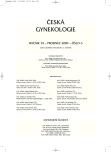Combination therapy with anticholinergics and alpha-blockers for the treatment of overactive bladder in female patients – pilot study
Authors:
J. Krhut 1; M. Gärtner 2; O. Havránek 1; D. Němec 1; J. Tvrdík 3
Authors‘ workplace:
Urologické oddělení FN Ostrava – Poruba, primář MUDr. J. Krhut, Ph. D.
1; Gynekologicko–porodnická klinika FN Ostrava – Poruba, přednosta MUDr. O. Šimetka
2; Katedra informatiky a počítačů, Přírodovědecká fakulta Ostravské univerzity Ostrava, vedoucí doc. ing. C. Klimeš, CSc.
3
Published in:
Ceska Gynekol 2009; 74(6): 416-420
Overview
Introduction:
Overactive bladder (OAB) is one of the most common medical conditions with an estimated 16 percent of adult population being affected in Europe. The administration of anticholinergics is considered as the most frequent and most effective treatment. There is a evidence that alpha-blockers affect a detrusor function. The aim of the study is to investigate if the combinant therapy consisting of anticholinergics plus alpha-blockers could be beneficial for women suffering from OAB.
Material and methods:
28 female patients with OAB were included into the pilot study. Mean age of the patients was 54,8 (42-77) years. Patients have been randomised into two groups: one group of patients has been treated by propiverin 30 mg daily, another group of patients has been treated by combination of both propiverin 30 mg daily and tamsulosin 0,4 mg daily.
Satisfaction with the treatment has been evaluated by I-QoL questionnaire. Semi-objective parameters have been obtained by analysis of 3-days voiding diaries (number of micturitions, number of urgency episodes, voided volume). Peak flow (Qmax) has been measured as a objective parameter.
Results:
We observed a decrease of frequency by 2,833 (-23,43%) comparing to base-line, decrease of number of urgency episodes by 1,417 (-36,22%), increase of voided volume by 33,333 ml (+19,14%), increase of quality of life index by 22,583(+51,52%) and increase of Qmax by 0,17 ml/s (+ 0,58%) in the propiverin group. We observed decrease of frequency by 3,813 (-30,48%), decrease of number of urgency episodes by 1,875 (-45,52%), increase of voided volume by 51,250 ml (+26,88%), increase of quality of life index by 33,438 (+76,0%) and increase of Qmax by 2,13 ml/s (+ 7,87%) in the combination treatment group. No significant difference has been found between both groups except the quality of life index.
Conclusion:
Our results can not show explicitly higher efficacy of combination treatment using anticholinergics plus alpha-blockers comparing to standard therapy by anticholinergics alone. Further randomised placebo–controlled studies are needed for final evaluation of the role of alpha-blockers in the treatment of OAB.
Key words:
lower urinary tract symptoms, overactive bladder, anticholinergics, alfa-blockers.
Sources
1. Andresson, KE. Alfa1- adrenoreceptors and bladder function. Eur Urol, 1999, 36, (Suppl. 1), p. 96-102.
2. Birder, LA., Apodaca, G., de Groat, WC., et al. Adrenergic- and capsaicin–evoked nitric oxide release from urothelium and afferent nerves in urinary bladder. Am J Physiol, 1998, 275, p. 226-229.
3. Hampel, C., Gillitzer, R., Pahernik, S., et al. Veränderungen des Rezeptorprofils der älternden Blase. Urologe A, 2004; 43, S. 535-541.
4. Heimbach, D., Muller, SC. Treatment of prostatic hyperplasia with alpha1-adrenoreceptor antagonist. Urologe A, 1997, 49, p. 18-34.
5. Lee, JZ., Tillig, B., Perkash, I., et al. Effect of alpha1 adrenoreceptor antagonist on the urodynamics of the upper and lower urinary tract in the male rat. Neurourol Urodyn, 1998, 17, p. 213-229.
6. Lepor, H., Theune, C. Randomized double-blind study comparing the efficacy of terazosin versus placebo in women with prostatism-like symptoms. J Urol, 1995, 154, 1, p. 116-118.
7. Low, BY., Liong, ML., Yuen, KH., et al. Terazosin therapy for patients with female lower urinary tract symptoms: a randomized, double-blind, placebo controlled trial. J Urol, 2008, 179, 4, p. 1461-1469.
8. Martan, A. Novinky v medikamentózní léčbě inkontinence moči u žen. Čas Lék čes, 2006, 14, 7, s. 549-553.
9. Serels, S., Stein, M. Prospective study comparing hyoscyamine, doxazosin, and combination therapy for the treatment of urgency and frequency in women. Neurourol Urodyn, 1998, 17, 1, p. 31-36.
10. Slavov, C., Dimitrov, R. LUTS in women and possible therapeutic effects of alfa1-adrenoblockers. Khirurgiia (Sofiia), 2004, 60, 4-5, p. 35-38.
Labels
Paediatric gynaecology Gynaecology and obstetrics Reproduction medicineArticle was published in
Czech Gynaecology

2009 Issue 6
Most read in this issue
- Prenatal intracranial hemorrhagie – diagnosis and follow-up
- Amniotic fluid interleukin 6 levels in preterm premature rupture of membranes
- Ovarian torsion in the first trimester gravidity after stimulation in vitro fertilization – case report
- Fertility preserving treatment of gynecological malignant tumors
